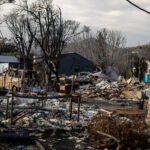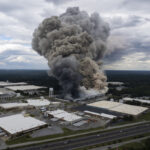New Orleans can get back to its comeback.
Traumatized after losing their homes when Hurricane Katrina’s floodwaters broke through the levees that protect this city, Hurricane Gustav ended up a mere interruption in rebuilding.
The fragile levees survived their first test in three years, holding firm and sheltering this saucer-shaped city from devastating floods. Residents can breathe a little easier — and start plotting their return to New Orleans.
The storm that crashed ashore as a Category 2 hurricane had by late Monday been downgraded to a tropical storm with maximum sustained winds of 60 mph.
“I just want to get back there ASAP,” said Hester Smith, 38, who had evacuated to a shelter in Milton, Fla.
It won’t be without some obstacles for residents of New Orleans. But Gustav didn’t cause the life-changing damage wrought by Katrina three years ago.
The storm also swirled into the fishing villages and oil-and-gas towns of Louisiana’s Cajun country, an already fragile terrain on the state’s southeastern coast.
In Plaquemines Parish, a levee was in danger of collapse, and officials scrambled to fortify it.
Roofs were torn from homes, trees toppled and roads flooded. More than 1 million homes were without power. And the extent of any damage to the oil and gas industry was unclear.
But the biggest fear — that the levees surrounding New Orleans would break — hadn’t been realized.
Wind-driven water sloshed over the top of the Industrial Canal’s floodwall — the same structure that broke with disastrous consequences during Katrina — and several Ninth Ward streets close by were flooded with ankle- to knee-deep water. Still, city officials and the Army Corps of Engineers expressed confidence the levees would hold.
Maj. Tim Kurgan, a Corps spokesman, said late in the day: “We don’t anticipate any problems, but we’re still watching this storm because it has not passed the area yet.”
Gustav blew ashore around 9:30 a.m. near Cocodrie (pronounced ko-ko-DREE), a low-lying community 72 miles southwest of New Orleans.
Forecasters had feared a catastrophic Category 4 storm on the 1-to-5 scale, but Gustav weakened as it drew close to land, coming ashore as a Category 2 with 110 mph winds. It quickly dropped to a Category 1 as it steamed inland toward Texas.
Late Monday, Gustav’s center was located about 20 miles southwest of Alexandria, lumbering northwest at about 13 mph. Forecasters expect the storm to weaken further to a tropical depression on Tuesday as it moves toward northeastern Texas. Storm surge flooding was expected to continue to subside overnight.
Authorities reported eight deaths related to the storm, including four people who were killed in Georgia when their car struck a tree as they attempted to flee the storm.
A 27-year-old Lafayette, La., man was killed when a tree fell on his house as the storm whipped through, and an Abbeville, La., couple were killed when a tree fell on a home in Baton Rouge. Before arriving in the U.S., Gustav was blamed for at least 94 deaths in the Caribbean.
In the days before the storm struck, nearly 2 million people fled coastal Louisiana under a mandatory evacuation order — a stark contrast from Katrina. Those evacuated included tens of thousands of poor, elderly and sick people who were put on buses and trains and taken to shelters and hotel rooms in several surrounding states.
It could be days until the full extent of the damage is known, especially in the fishing villages and oil-and-gas towns of bayou country, where rapid erosion in recent decades has destroyed swamps and robbed the area of a natural buffer against storms.
Keith Cologne of Chauvin, not far from Cocodrie, looked dejected after talking by telephone to a friend who didn’t evacuate. “They said it’s bad, real bad. There are roofs lying all over. It’s all gone,” said Cologne, staying at a hotel in Orange Beach, Ala.
In St. Mary Parish, to the west, Deputy Sheriff Troy Brown cleared roads with a chain saw as he went out to assess damage. He found uprooted trees, houses without some shingles, but few signs of monster hit. “Even the mobile homes are sitting there in one piece,” Brown said.
One community in southeastern Louisiana feared its levee wouldn’t hold. As many as 300 homes in Plaquemines Parish were threatened, and the parish president called a TV station to plead with any residents who stayed behind to flee.
It could be a day or more before oil and natural gas companies can assess the damage to their drilling and refining installations. Gov. Bobby Jindal said as much as 20 percent of oil and gas production that was stopped because of Gustav could be restored by this weekend, stressing that it was a rough estimate.
To the east of the city, state officials were unable to reach anyone at Port Fourchon, a vital energy industry hub where huge amounts of oil and gas are piped inland to refineries.
The Gulf of Mexico accounts for about 25 percent of domestic oil production and 15 percent of natural gas output. Damage to those installations could cause gasoline prices at the pump to spike, although oil prices declined Monday.
While Katrina smashed the Gulf Coast with an epic storm surge that topped 27 feet, the surge this time in New Orleans reached 12 feet, near the top of the Industrial Canal, on the eastern side of the city.
Officials expressed confidence all day long that the flood defenses in the eastern part of the city would hold. They were more concerned about the West Bank of the Mississippi River, where the $15 billion in levee improvements begun after Katrina have yet to be completed. But those floodwalls appeared to be holding, too.
Gustav was quickly marching inland, reducing the prospect of heavy rain in southern Louisiana. “From what I’ve seen, New Orleans metro should be back in business” on Tuesday, said Bill Read, director of the National Hurricane Center.
But Read said the storm will slow down as it heads into Texas and possibly into Arkansas, and could bring 20 inches of rain to those areas.
The Federal Emergency Management Agency stood ready to distribute enough cartons of food, water, blankets and other supplies to sustain 1 million people for three days — another contrast to Katrina, when thousands waited for rescue in the sweltering Superdome.
“With Katrina they didn’t come and rescue us until the next day,” said LaTriste Washington, 32, who stayed in her home during the 2005 hurricane and was rescued by boat. She was in a shelter in Birmingham, Ala., on Monday. “This time they were ready and had buses lined up for us to leave New Orleans.”
President Bush skipped the opening day of a scaled-back Republican National Convention to monitor the storm’s progress, and both Republicans and Democrats asked supporters to text-message donations to the Red Cross to help victims of the hurricane.
New Orleans Mayor Ray Nagin hinted the city could be reopened as early as Tuesday, once the city assesses damage and is sure its neighborhoods are safe. Drinking water continued to flow in the city and the pumps that keep it dry never shut down, two critical service failings that contributed to Katrina’s toll. But two-thirds of the city’s electric customers were without power, as the storm damaged transmission lines that snapped like rubber bands in the wind and knocked 35 substations out of service.
The decision to reopen the city was eagerly awaited by those who fled the coast and watched the storm unfold on TV from shelters across the region.
Fights broke out at an overcrowded shelter in Shreveport. People who had slept, eaten and lived on cots for days struggled to get news about home from the lone television in the entire center. Doctors worried about medications running out and seven people were hospitalized, all in stable condition.
“People are desperate. They don’t know if they are going to have a place to go home to,” said Emma McClure, 37, who was at the shelter with her three children, three sisters and some 20 nephews. “They had three years to plan this and now I wish I had stayed in the city like I did during Katrina.”
In Mississippi, at least three people had to be rescued from the floodwaters. An abandoned building in Gulfport collapsed, a few homes in Biloxi were flooded, and the ground floor of the Hard Rock Hotel and Casino on Biloxi’s casino row was swamped with 21/2 feet of water. Katrina smashed the casino three years ago shortly before it was to open.
As Gustav passed, authorities turned their attention to Hurricane Hanna, which could come ashore in Georgia and South Carolina late in the week.
In New Orleans, many trees, light poles, traffic lights and signs had been blown down, and debris was strewn across the streets. But there was no flooding or major damage, and the storm brought only 3 inches of rain or less to the city. Police reported making just a single arrest.
Gerald Boulmay, 61, a hotel employee in New Orleans, emerged into a dry French Quarter not long after the rain stopped in midafternoon. The skies were brightening and the wind was breezy. But mindful of how the full extent of Katrina’s damage did not become clear until the storm had passed, he was still worried about a levee breach.
“I don’t think we’re out of the woods,” Boulmay said. “We still have to worry about the water.”
__
Associated Press writers Becky Bohrer, Cain Burdeau, Allen G. Breed contributed to this report from New Orleans. Janet McConnaughey and Alan Sayre contributed from Hammond. Doug Simpson in Baton Rouge, Michael Kunzelman in Lafayette, La., and Holbrook Mohr in Gulfport, Miss., also contributed.
Was this article valuable?
Here are more articles you may enjoy.

 California Again Delays Wildfire Protection Rules for Homes
California Again Delays Wildfire Protection Rules for Homes  Verlan Files Subro Suit Against Georgia Chemical Plant After $20M Payout on Fire
Verlan Files Subro Suit Against Georgia Chemical Plant After $20M Payout on Fire  Hermès Heir Sues Arnault and LVMH in $16 Billion Suit Over Lost Shares
Hermès Heir Sues Arnault and LVMH in $16 Billion Suit Over Lost Shares  Zillow Deleting Climate Risk Scores Reveals Limits of Flood, Fire Data
Zillow Deleting Climate Risk Scores Reveals Limits of Flood, Fire Data 